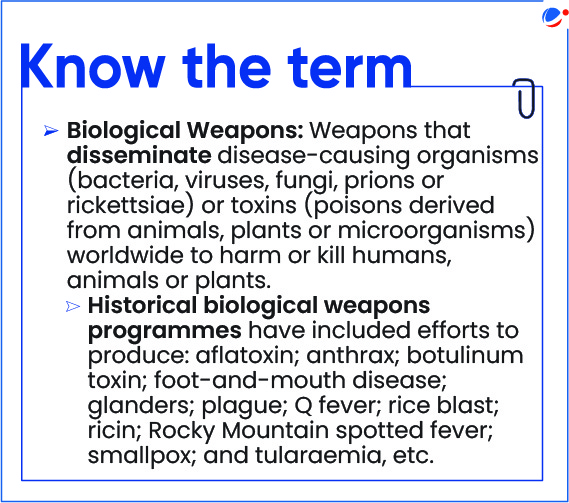Why in the News?
United Nations Office for Disarmament Affairs (UNODA) celebrated 50th anniversary Biological Weapons Convention (BWC).
About Biological Weapons Convention (BWC)
- Formally known as "The Convention on the Prohibition of the Development, Production and Stockpiling of Bacteriological (Biological) and Toxin Weapons and on their Destruction".

- Genesis: Negotiated in Geneva, Switzerland within the Eighteen Nation Committee on Disarmament (ENDC) and Conference of the Committee on Disarmament (CCD) from 1969 until 1971.
- Opened for signature in 1972 and entered into force in 1975.
- Membership: Almost universal membership with 188 States Parties (India signed and ratified in 1974) and 4 Signatory States (Egypt, Haiti, Somalia, Syrian Arab Republic).
- States Parties meet approximately every 5 years to review its operation.
- States Parties to BWC have strived to ensure that Convention remains relevant and effective, despite the changes in science and technology, politics and security since it entered into force.
- Key facts about the BWC
- 1st multilateral disarmament treaty banning an entire category of weapons of mass destruction (WMD).
- Effectively prohibits the development, production, acquisition, transfer, stockpiling and use of biological and toxin weapons.
- Supplements the 1925 Geneva Protocol, which had prohibited only the use of biological weapons.
- Implementation Support Unit (ISU) to provide administrative support to meetings agreed by Review Conference, comprehensive implementation, universalization of the Convention.
- 5 States- Israel, Chad, Djibouti, Eritrea and Kiribati have neither signed nor acceded to the Convention.

Measures taken by India to implement Biological Weapons Convention (BWC)
|
Challenges related to BWC
- Lack of a Verification Mechanism: Unlike other major disarmament treaties, Dual-use nature of bioscience makes it difficult to differentiate between peaceful and offensive applications from an accounting-driven framework.
- In case of Chemical Weapons Convention, verification is based on framework driven by accounting that involves documentation of facilities, tools, and raw materials of relevance etc.
- Lack of legally enforceable data collecting provision: It contributes to BWC reliance on politically binding confidence-building measure (CBM) submissions.
- CBM suffers from low participation (2022 was the first year that over 50% of states parties submitted a CBM).
- Limited Institutional support: Implementation Support Unit (ISU) is understaffed, it was only at Ninth Review Conference that ISU increased its staffing from 3 non- permanent staff to 4, since its inception in 2006.
- Insufficient National Implementation: For e.g., India has a National Authority for Chemical Weapons Convention (NACWC) but lacks a similarly centralized body for the Biological Weapons Convention (BWC).
Way forward
- Implement Modular-Incremental Approach for Verification: This approach focuses on integrating various policy proposals and scientific tools to create a more robust verification regime.
- Expand Permanent Institutional Support: Appoint a rotating expert verification group under the UN Secretary-General, comprising disarmament specialists and biotechnology industry experts to oversee BWC compliance.
- Universalize Confidence-Building Measure Submissions: Recent advances in artificial intelligence and natural language processing have the potential to make some CBM submissions easier, such as through the use of data harmonization and text mining.
- Address Non-State Actor Threats: Integrating BWC with UN Security Council Resolution 1540 to prevent non-state actors (terrorist groups) from acquiring, developing, or using biological weapons.



